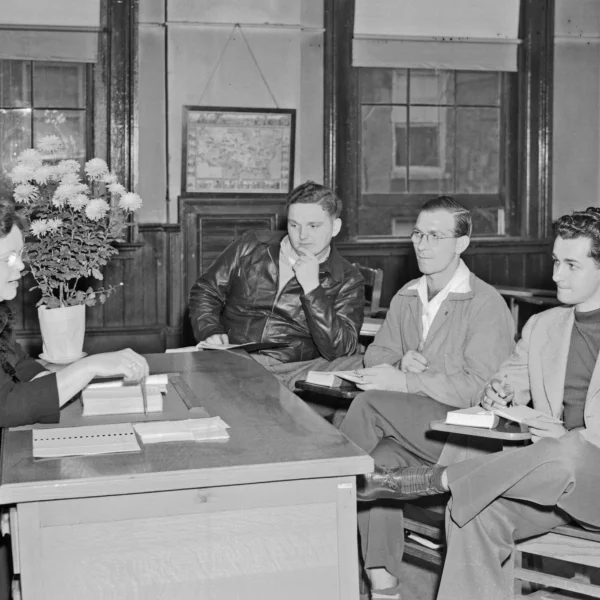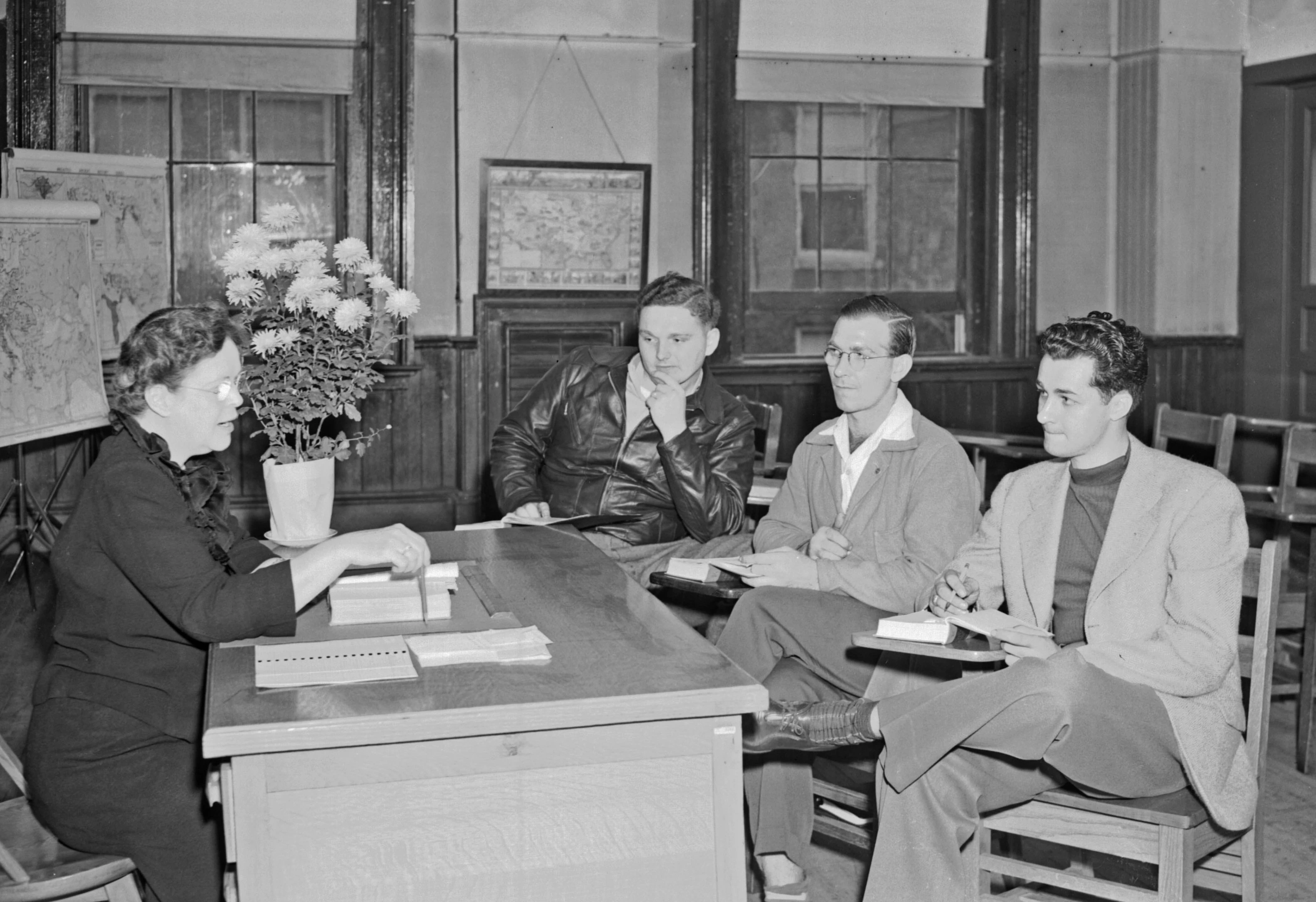After World War II, Illinois State Normal University put out the welcome mat for returning soldiers and sailors looking to reintegrate into civilian life.
By the fall of 1945, the war had come to a close with Victory over Japan (V-J) Day, September 2. Yet preparations for the return of veterans were well underway, as many from Europe and elsewhere were already discharged and either back home or in the process of returning stateside. As a result, during the 1945-1946 academic year, ISNU offered a new veterans’ student organization, a federally funded veterans’ counseling center, a faculty committee on veterans, and even a campus-based high school for veterans who, due to the war, were unable to finish their secondary education.
At this time, ISNU was still a “normal” school, meaning the education of teachers was still its primary mission. It was thought that teaching was an ideal postwar profession for many veterans who, if nothing else, returned from war-torn Europe and the Pacific instilled with leadership skills, discipline, motivation and other personal and social proficiencies translatable—in theory at least—to the classroom.
During the 1945-1946 school year, Walter V. Brown, state director of veterans’ education and rehabilitation, addressed the Golden Eagles, the newly established veterans’ student organization at ISNU. “You are preparing for a much-needed profession, and the Veterans’ Administration is pleased to have so many veterans enrolled at the oldest state teachers college in Illinois,” he told the group. Joe Cogdal, ISNU’s legendary basketball and track and field coach, served as the Golden Eagles’ faculty sponsor.
Established in the spring of 1945, the Veterans’ Guidance and Counseling Center on the ISNU campus served the physical and emotional needs of able-bodied and disabled veterans. It was one of a several such centers in the state, all operating under the direction of the Edward Hines Jr. Veterans Administration Hospital outside of Chicago. The ISNU center covered a 15-county area, which reached as far north as Stark and Marshall counties, and as far south as Christian County.
The Guidance and Counseling Center was first located on the second floor of Cook Hall, but was later moved to a recently vacated U.S. Navy infirmary on the 300 block of West Mulberry Street. The infirmary had been part of a campus-based naval training program.
ISNU faculty from the special education and psychology departments helped staff the center. Disabled veterans were encouraged to seek vocational training, with radio, refrigeration, business administration and auto mechanics said to be the four most popular occupational tracks. Many of these veterans then had the option to continue their education at a college or university, a business or trade school, or through an apprenticeship in the trades.
When it closed in the spring of 1947, the Guidance and Counseling Center had tested or counseled more than 800 veterans.
The campus-based veterans’ school, which operated from September 1945 to June 1947, offered servicemen and women a chance to complete their high school education interrupted by wartime service. Dr. Victor M. Houston, principal of University High, acted as the new school’s administrative head. ISNU faculty members serving as tutors included Dr. Nell Waldron, professor of social science (see accompanying photograph), and C.L. Cross and Leon Smith, both professors of physical science.
The school, it was said, offered veterans the “opportunity to complete high school work without actually reenrolling in high school.” Most of the instruction was one-on-one, on an “accelerated tutorial plan,” though students did meet in small groups as necessary. Under the Servicemen's Readjustment Act of 1944, commonly known as the GI Bill, veterans were only responsible for the cost of their books and room and board.
Students at this veterans’ school worked at their own speed, and could choose one of two courses of study. Upon attaining “sufficient knowledge of the fundamentals of the field,” some students opted to take a subject-specific test to earn credit for that course, and after passing a predetermined number of courses they received their diploma.
A more popular path to graduation involved General Educational Development (GED) tests, which came about during WW II for this specific purpose. In late 1942, the Armed Forces Institute called upon the American Council on Education to develop a series of examinations to measure academic aptitude at the high school level (in the subjects of reading, writing, social studies, science and mathematics), so returning soldiers and sailors whose education was cut short by the war could more quickly and easily earn a high school diploma. Today, GED can also stand for General Equivalency Development or General Equivalency Diploma.
Graduates of the veterans’ school also had the choice to receive their diploma through University High or from their school back home. Not surprisingly, most out-of-towners stayed true to their roots and preferred the sheepskin coming from their hometown high school. And many of those who received high school diplomas through this veterans’ program continued their education. Fifteen of the 18 students who graduated in late January 1946, for instance, promptly enrolled at ISNU.
Fifteen veterans, ranging in age from 20 to 45 years old, earned highs school diplomas in late May 1946. This graduating class included Amy Wiggers of Bloomington, the first woman to graduate. Wiggers participated in May 31 University High commencement ceremony at ISNU’s Capen Auditorium. Forty-five year old Donald G. Joda, on the other hand, received his diploma from Fairbury High School in Livingston County.
Because veterans studied at their own pace, some proceeded cautiously, while others raced through the subject matter at breakneck speed. No one, though, likely beat Jay Dawson Carpenter’s record pace. “Completes 2 years of school in 2 days,” marveled The Pantagraph in early April 1946.
Before the war, Carpenter completed two years at Empire Township High School in LeRoy. He then served six years in the U.S. Army, rising to the rank of captain as an intelligence officer with the 42nd Division in Europe. After his discharge on March 6, 1946, Carpenter returned to McLean County (his parents were now living in Normal), and enrolled in the veterans’ school.
After two days of classes, he announced he was ready to take the GED tests and qualify for a high school diploma. And sure enough, he passed with relative ease. On April 6, one month after his discharge, Carpenter received a diploma from his old school, Empire Township High.
In August 1946, 23 students received diplomas from the veterans’ school at ISNU. Graduates included Bette Cleinmark and Alvin Schad, both of Bloomington, and 22-year-old identical twins David and John Haenni of Staunton, Ill. There were also graduates from a scattering of Central Illinois communities, including Clinton, Minier, Minonk, Odell, Shirley, Streator and Washington.
In its nearly two years of existence, 186 men and women enrolled in the veterans’ school, with more than 200 earning general equivalency diplomas.

